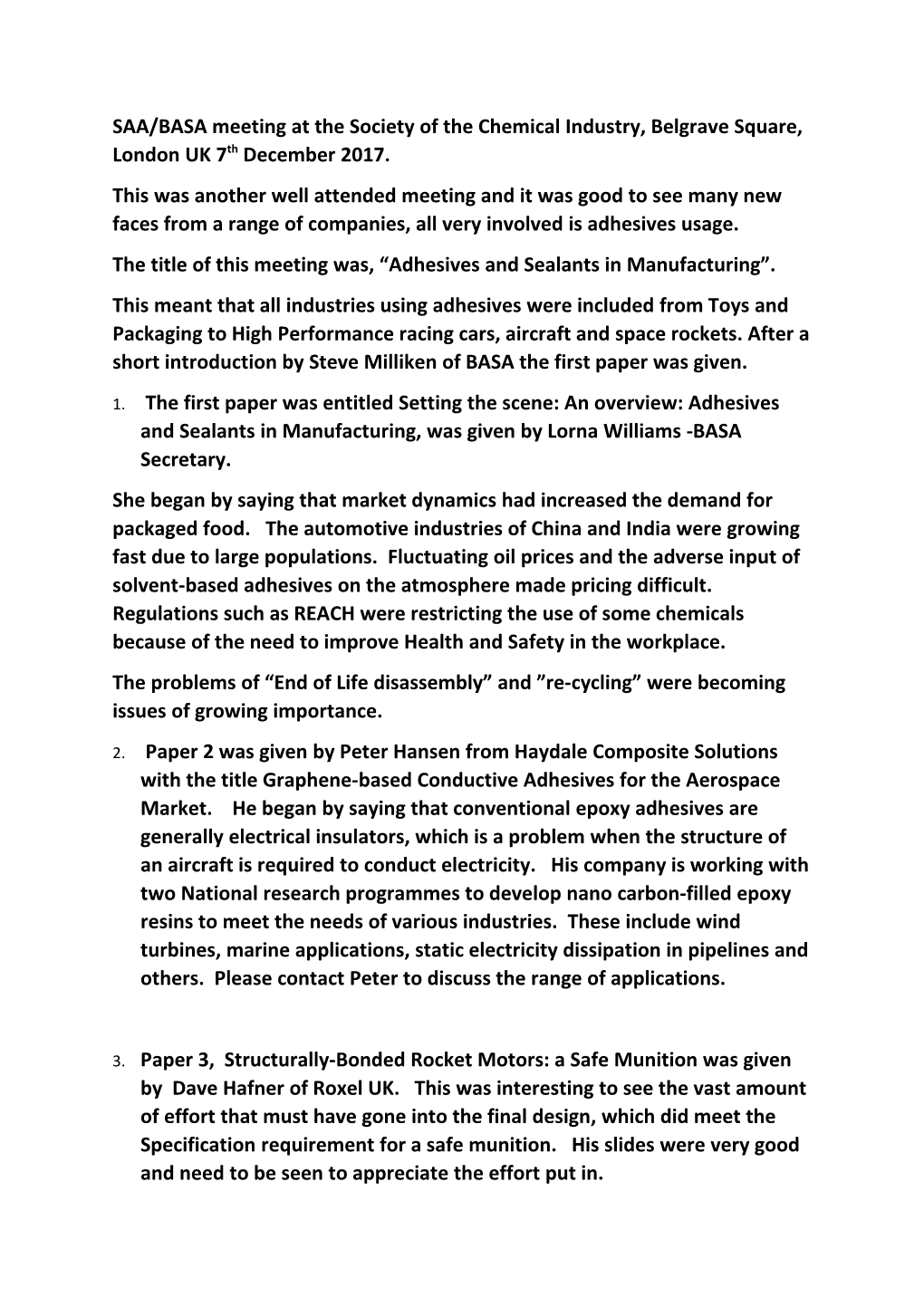SAA/BASA meeting at the Society of the Chemical Industry, Belgrave Square, London UK 7th December 2017.
This was another well attended meeting and it was good to see many new faces from a range of companies, all very involved is adhesives usage.
The title of this meeting was, “Adhesives and Sealants in Manufacturing”.
This meant that all industries using adhesives were included from Toys and Packaging to High Performance racing cars, aircraft and space rockets. After a short introduction by Steve Milliken of BASA the first paper was given.
- The first paper was entitled Setting the scene: An overview: Adhesives and Sealants in Manufacturing, was given by Lorna Williams -BASA Secretary.
She began by saying that market dynamics had increased the demand for packaged food. The automotive industries of China and India were growing fast due to large populations. Fluctuating oil prices and the adverse input of solvent-based adhesives on the atmosphere made pricing difficult. Regulations such as REACH were restricting the use of some chemicals because of the need to improve Health and Safety in the workplace.
The problems of “End of Life disassembly” and ”re-cycling” were becoming issues of growing importance.
- Paper 2 was given by Peter Hansen from Haydale Composite Solutions with the title Graphene-based Conductive Adhesives for the Aerospace Market. He began by saying that conventional epoxy adhesives are generally electrical insulators, which is a problem when the structure of an aircraft is required to conduct electricity. His company is working with two National research programmes to develop nano carbon-filled epoxy resins to meet the needs of various industries. These include wind turbines, marine applications, static electricity dissipation in pipelines and others. Please contact Peter to discuss the range of applications.
- Paper 3, Structurally-Bonded Rocket Motors: a Safe Munition was given by Dave Hafner of Roxel UK. This was interesting to see the vast amount of effort that must have gone into the final design, which did meet the Specification requirement for a safe munition. His slides were very good and need to be seen to appreciate the effort put in.
- Paper 4, Adhesives in Dyson Digital Motors was given by Dave Ions from Dyson. It quickly became clear that most of their work is done in Singapore but the level of automation they have developed was truly amazing. You have to see the film to appreciate this work and can probably get one from Dyson on request. The numbers are impressive to say the least. 40 Million motors made since 2004, 720 million adhesive joints in service.
- Paper 5, Novel Hybrid Adhesives for High Performance Applications, was given by Bob Goss from Henkel. This was an impressive paper covering a wide range of Adhesive types. As usual these days it contains many excellent pictures that need to be seen. Please request a copy if needed. He covered nine types of adhesives for a wide range of uses. In particular he introduced a new range of hybrid adhesives. One of these is a Cyanoacrylate/epoxy hybrid. He introduced three new types. Loctite 4070 A universal repair adhesive, Loctite 4080 A tough, robust structural bonder, Loctite 4080 A tough and robust structural bonder and Loctite 4090 An epoxy Cyanoacrylate hybrid. The last has the best properties. Contact for info on these. To contact Bob he is a Senior Technology Specialist, General Industry Division, Henkel Ltd.
- Paper 6 Adhesive Application in Formula 1 was given by Brian O’Rourke from Williams Racing . He is Chief Composites Engineer at Williams Grand Prix Engineering Ltd. This paper again had many superb pictures and showed just how much effort goes in to producing lightweight but safe composite parts. This is important todriver safety as the cockpit design is a matter of life or death in a bad crash.
- Paper 7 Industrial Applications of High Performance Sealants, was given by Phil Duke from DSTL. This paper also used many good slides so request a copy of the paper if you need one. The paper includes a lot of very useful references and covers everything from sealing around the edge of a bath or kitchen sink,to aircraft or rocket fuel tanks and raises many points of practical value for DIY at home as well as work.Finally he also raised the issue of sealants, that like adhesives, need to be easy to dismantle for re-cycling after use but in some cases after serving reliably for up to about 40 years in service.
This was a useful meeting and brought us more up to date with current developments.
For details of future meetings please contact
D.A.Tod
QinetiQ X50
Fort Halstead,
Sevenoaks,
Kent TN14-7BP
Tel: 01959-514492
FX 01959-516041
